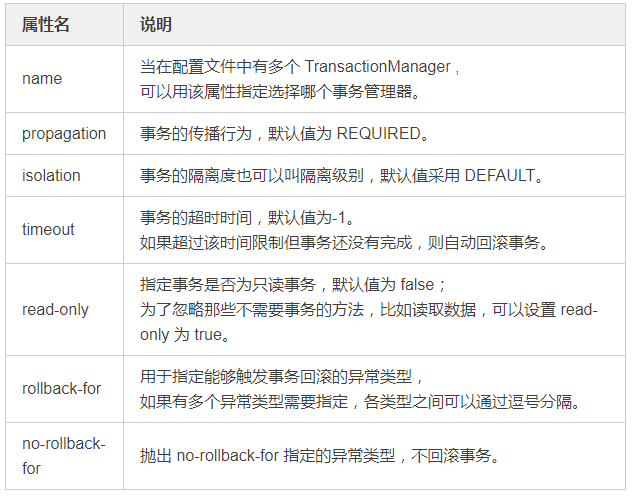一文搞懂 Spring 数据库事务操作!


作者 | 阿文, 责编 | 郭芮
头 图 | CSDN 下载自东方IC
出品 | CSDN(ID:CSDNnews)
今天我们一起了解下Spring的数据库事务操作。在操作数据库时,我们经常会使用到事务,为此Spring 提供了专门的用于处理事务的API方便开发者调用,那么本文就着重来讲解下Spring 对于事务的相关功能。

Spring 事务的核心接口
Spring 通过一个名为spring-tx-4.3.6-RELEASE 的JAR包来管理事务,在这个JAR包中的org.Springframework.transaction 包中包含了三个接口文件:
-
PlatformTramsactionManager 主要用于管理事务,包括获取事务的状态、提交事务和回滚事务;
-
TramsactionDefinition 该接口是事务定义的对象,包括了获取事务的名称、隔离级别、事务的传播行为、超时时间、事务是否只读等;
-
TramsactionStatus 该接口是事务的状态,描述了某一个时间点事务状态信息,包括刷新事务、获取是否存在保存点、是否是新事务、是否回滚、设置事务回滚。

实例讲解
接下来我们将通过实例的方式来讲解如何使用注解的方式来通过Spring 进行事务的处理,手续我们在maven的pom.xml 中增加事务的JAR包:
< dependency >
< groupId > org.springframework </ groupId >
< artifactId > spring-tx </ artifactId >
< version > 4.3.6.RELEASE </ version >
</ dependency >
我们首先准备一个数据库:
CREATE TABLE IF NOT EXISTS `user` (
`id` INT UNSIGNED AUTO_INCREMENT,
`username` VARCHAR ( 100 ) NOT NULL ,
`password` VARCHAR ( 40 ) NOT NULL ,
`jifen` int ( 10 ) NOT NULL ,
PRIMARY KEY ( `id` )) ENGINE = InnoDB DEFAULT CHARSET =utf8;
然后向数据库中写入一些数据,包括了用户名、密码和积分,如下所示:
MariaDB [spring_db]> select * from user;
+----+----------+----------+-------+
|
+----+----------+----------+-------+
1 | zhangsan | 123 | 1000 ||
3 | wangwu | 1234 | 1000 |+----+----------+----------+-------+
3 rows in set ( 0 . 000 sec)
我们要做的事情就是把张三的积分转给李四。
我们需要创建一个 User 类,如下:
package com.SpringDemo;
public class User {
private Integer id;
private String username;
private String password;
private Integer jifen;
public Integer getId () {
return id;
}
public void setId (Integer id) {
this .id = id;
}
public String getUsername () {
return username;
}
public void setJifen (Integer jifen) {
this .jifen = jifen;
}
public Integer getjifen () {
return jifen;
}
public void setUsername (String username) {
this .username = username;
}
public String getPassword () {
return password;
}
public void setPassword (String password) {
this .password = password;
}
public String toString () {
return "User [id=" + id + ", username=" + username + ", password=" + password + "]" ;
}
}
然后创建一个接口 UserDao:
package com.SpringDemo;
import java.util.List;
public interface UserDao {
public int addUser (User user) ;
public int updateUser (User user) ;
public int deleteUser ( int id) ;
//通过id查询用户
public User findUserById ( int id) ;
//查询所有用户
public List<User> findAllUser () ;
public void transfer (String outUser,String inUser,Integer jifen) ;
}
在UserDao 接口中我们定义了一个transfer 的方法,它包含了三个参数分别是outUser、inUser、jifen。
接来下我们定义实现类 UserDAOImpl:
package com.SpringDemo;
import org.springframework.jdbc.core.BeanPropertyRowMapper;
import org.springframework.jdbc.core.JdbcTemplate;
import org.springframework.jdbc.core.RowMapper;
import org.springframework.transaction.annotation.Isolation;
import org.springframework.transaction.annotation.Propagation;
import org.springframework.transaction.annotation.Transactional;
import java.util. List ;
public class UserDaoImpl implements UserDao {
private JdbcTemplate jdbcTemplate;
public void setJdbcTemplate(JdbcTemplate jdbcTemplate) {
this .jdbcTemplate = jdbcTemplate;
}
@Override
public int addUser(User user) {
String sql= "insert into user(username,password) value(?,?)" ;
Object [] obj= new Object []{
user.getUsername(),
user.getPassword()
};
int num = this .jdbcTemplate.update(sql,obj);
return num ;
}
@Override
public int updateUser(User user) {
String sql= "update user set username=?,password=? where id=?" ;
Object [] params= new Object []{
user.getUsername(),
user.getPassword(),
user.getId()
};
int num = this .jdbcTemplate.update(sql,params);
return num ;
}
@Override
public int deleteUser( int id) {
String sql= "delete from user where id=?" ;
int num = this .jdbcTemplate.update(sql,id);
return num ;
}
@Override
public User findUserById( int id) {
String sql= "select * from user where id=?" ;
RowMapper<User> rowMapper= new BeanPropertyRowMapper<User>(User. class );
return this .jdbcTemplate.queryForObject(sql,rowMapper,id);
}
@Override
public List <User> findAllUser() {
String sql= "select * from user" ;
RowMapper<User> rowMapper= new BeanPropertyRowMapper<User>(User. class );
return this .jdbcTemplate.query(sql,rowMapper);
}
@Override
public void transfer( String outUser, String inUser, Integer jifen) {
// 赠送积分
this .jdbcTemplate.update( "update user set jifen=jifen+? where username=?" ,jifen,inUser);
// 模拟系统运行时的突发性问题
int i = 1 / 0 ;
//赠送出积分
this .jdbcTemplate.update( "update user set jifen=jifen-? where username=?" ,jifen,outUser);
}
}
接下来我们定义一个applicationContext.xml:
<?xml version="1.0" encoding="UTF-8"?>
< beans xmlns = "http://www.springframework.org/schema/beans"
xmlns:xsi = "http://www.w3.org/2001/XMLSchema-instance"
xmlns:aop = "http://www.springframework.org/schema/aop"
xmlns:tx = "http://www.springframework.org/schema/tx"
xmlns:context = "http://www.springframework.org/schema/context"
xsi:schemaLocation=
"http://www.springframework.org/schema/beans
http://www.springframework.org/schema/beans/spring-beans-4.3.xsd
http://www.springframework.org/schema/tx
http://www.springframework.org/schema/tx/spring-tx-4.3.xsd
http://www.springframework.org/schema/context
http://www.springframework.org/schema/context/spring-context-4.3.xsd
http://www.springframework.org/schema/aop
<!--1.配置数据源 -->
< bean id = "dataSource"
class=
"org.springframework.jdbc.datasource.DriverManagerDataSource"
<!--数据库驱动 -->
< property name = "driverClassName" value = "com.mysql.jdbc.Driver" />
<!--连接数据库的ur1 -->
< property name = "url" value = "jdbc:mysql://192.168.10.128:3306/spring_db" />
<!--连接数据库的用户名 -->
< property name = "username" value = "root" />
<!--连接数据库的密码 -->
< property name = "password" value = "123456" />
</ bean >
<!--2.配置JDBC模板 -->
< bean id = "jdbcTemplate" class = "org.springframework.jdbc.core.JdbcTemplate" >
<!--默认必须使用数据源 -->
< property name = "dataSource" ref = "dataSource" />
</ bean >
<!--3.定义id为userDao的Bean -->
< bean id = "userDao" class = "com.SpringDemo.UserDaoImpl" >
<!--将 jdbcTemplate注入到 userDao实例中 -->
< property name = "jdbcTemplate" ref = "jdbcTemplate" />
</ bean >
<!--4.事务管理器,依赖于数据源 -->
< bean id = "transactionManager" class = "org.springframework.jdbc.datasource.DataSourceTransactionManager" >
< property name = "dataSource" ref = "dataSource" />
</ bean >
<!--5.注册事务管理驱动 -->
< tx:annotation-driven transaction-manager = "transactionManager" ></ tx:annotation-driven >
</ beans >
Spring 的事务管理方式有2种,一种是传统的编程序事务管理,即通过代码来管理事务的开始、执行和异常以及回滚,一种是声明式管理,即通过配置文件的方式,原理是通过AOP技术实现,我们在实际开发过程中推荐使用声明式事务管理,效率会大大提升,因为只需要通过配置即可。
在该接口中我们我们重写transfer的方法,更新数据库将inUser 的积分进行增加,而对应的outUser 积分要进行减少,但是在这里我们要模拟系统运行的一些突然性问题。之后我们加了一个@Transactionl 注解,并设置了propagation、Isolation、readOnly 三个参数。
@Override
@Transactional (propagation = Propagation.REQUIRED,isolation = Isolation.DEFAULT,
readOnly = false )
public void transfer (String outUser, String inUser, Integer jifen) {
// 赠送积分
this .jdbcTemplate.update( "update user set jifen=jifen+? where username=?" ,jifen,inUser);
// 模拟系统运行时的突发性问题
int i = 1 / 0 ;
//赠送出积分
this .jdbcTemplate.update( "update user set jifen=jifen-? where username=?" ,jifen,outUser);
}
注解 @Transactional 的参数含义如下:

@Transactional 除了 DEFAULT,还有其他属性,我们可以在Isolation 这个类中看到相对于的定位 @Transactional 注解也可以添加到类级别上。当把@Transactional 注解放在类级别时,表示所有该类的公共方法都配置相同的事务属性信息。
public enum Isolation {
DEFAULT( -1 ),
READ_UNCOMMITTED( 1 ),
READ_COMMITTED( 2 ),
REPEATABLE_READ( 4 ),
SERIALIZABLE( 8 );
private final int value ;
private Isolation ( int value ) {
this . value = value ;
}
public int value () {
return this . value ;
}
}
Propagation 的属性如下:
public enum Propagation {
REQUIRED( 0 ), //表示当前方法必须运行在一个事务环境中,如果存在就直接使用,否则开启一个新的事务执行该方法
SUPPORTS( 1 ), //如果当前方法处于事务环境中则使用,否则不使用事务
MANDATORY( 2 ), //表示该方法的线程必须在事务中否则抛出异常
REQUIRES_NEW( 3 ), //要求在新事务中执行,如果已经在事务中了则先暂停然后启动新事务执行,如果不在则启动一个新事务后执行
NOT_SUPPORTED( 4 ), //不支持当前事务,总是以非事务状态执行,如果调用该方法的线程处于事务中泽先暂停然后执行
NEVER( 5 ), //不支持当前执行的方法在事务中,如果在抛出异常
NESTED( 6 ); //即便当前执行的方法在事务中也会启动一个新事务,然后执行该方法
private final int value ;
private Propagation ( int value ) {
this . value = value ;
}
public int value () {
return this . value ;
}
}
此外使用@Transactional 必须保证是在public 级别的方法中使用,@Transactional 只能应用到 public 方法才有效,这是因为在使用 Spring AOP 代理时,Spring 在调用 TransactionInterceptor 在目标方法执行前后进行拦截之前,DynamicAdvisedInterceptor(CglibAopProxy 的内部类)的的 intercept 方法或 JdkDynamicAopProxy 的 invoke 方法会间接调用 AbstractFallbackTransactionAttributeSource(Spring 通过这个类获取 @Transactional 注解的事务属性配置属性信息)的 computeTransactionAttribute 方法。
接下来我们创建一个测试类来进行测试:
package com.SpringDemo;
import org.springframework.context.ApplicationContext;
import org.springframework.context.support.ClassPathXmlApplicationContext;
public class TransactionTest {
public static void main (String[] args) {
ApplicationContext applicationContext =
new ClassPathXmlApplicationContext( "applicationContext.xml" );
UserDao userDao = (UserDao) applicationContext.getBean( "userDao" );
userDao.transfer( "zhangsan" , "lisi" , 100 );
System.out.println( "赠送积分成功" );
}
}
我们执行上述程序,可以发现报错了。程序报:
Exception in thread "main" java.lang.ArithmeticException: / by zero
如图所示:

此时,我们查看数据库中的数据没有发生任何变化:
MariaDB [spring_db]> select * from user;
+----+----------+----------+-------+
|
+----+----------+----------+-------+
1 | zhangsan | 123 | 1000 ||
3 | wangwu | 1234 | 1000 |+----+----------+----------+-------+
3 rows in set ( 0 . 000 sec)
而当我们把 int i =1/0; 注释掉再次执行就会发现程序执行没有报错了,并且数据发生了变化:
MariaDB [spring_db]> select * from user;
+----+----------+----------+-------+
|
+----+----------+----------+-------+
1 | zhangsan | 123 | 900 ||
3 | wangwu | 1234 | 1000 |+----+----------+----------+-------+
3 rows in set ( 0 . 000 sec)
好了,以上就是关于Spring的事务管理介绍。

【END】

更多精彩推荐
☞ 斩获GitHub 2000+ Star,阿里云开源的 Alink 机器学习平台如何跑赢双11数据“博弈”? | AI 技术生态论
☞ 2020 年,AI 芯片内存哪家强?
☞ 拜托,别再问我什么是 B+ 树了
☞ 程序员为什么应该旗帜鲜明地反对“最佳实践”?
☞ 半小时训练亿级规模知识图谱,亚马逊AI开源知识图谱嵌入表示框架DGL-KE
☞ “出道” 5 年采用率达 78%,Kubernetes 的成功秘诀是什么?
☞ 警惕!新骗术出现:这些虚假二维码生成器已成功盗取 4.6 万美元!
今日福利:评论区留言入选,可获得价值299元的「2020 AI开发者万人大会」在线 直播门票一张 。 快来动动手指,写下你想说的话吧。
点击阅读原文,精彩继续!
你点的每个“在看”,我都认真当成了喜欢
- 本文标签: 数据 http 时间 IO java value sql dataSource API Property classpath Kubernetes JDBC find 参数 开发者 core 代码 mapper spring pom key 双11 Uber 管理 下载 测试 程序员 传播行为 tar 阿里云 UI src GitHub ORM 云 zab maven XML cat 开源 NSA ACE App id root https 二维码 配置 lib SDN bean mysql db 实例 cglib 线程 final IDE Word 注释 AOP update git list map schema 亚马逊 Action tab Select Proxy 数据库 开发
- 版权声明: 本文为互联网转载文章,出处已在文章中说明(部分除外)。如果侵权,请联系本站长删除,谢谢。
- 本文海报: 生成海报一 生成海报二











![[HBLOG]公众号](https://www.liuhaihua.cn/img/qrcode_gzh.jpg)

